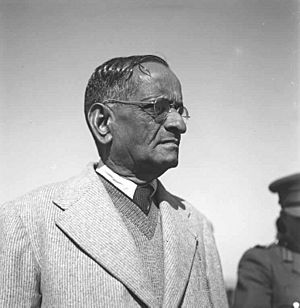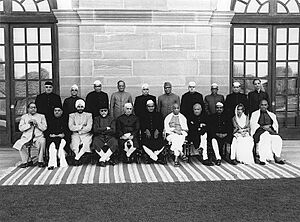N. Gopalaswami Ayyangar facts for kids
Quick facts for kids
N. Gopalaswami Ayyangar
|
|
|---|---|
 |
|
| 2nd Minister of Defence | |
| In office 13 May 1952 – 10 February 1953 |
|
| President | Rajendra Prasad |
| Prime Minister | Jawaharlal Nehru |
| Preceded by | Baldev Singh |
| Succeeded by | Jawaharlal Nehru |
| 1st Leader of the House in Rajya Sabha | |
| In office 13 May 1952 – 10 February 1953 |
|
| President | Rajendra Prasad |
| Prime Minister | Jawaharlal Nehru |
| Preceded by | Position established |
| Succeeded by | Charu Chandra Biswas |
| Minister of Railways & Transport | |
| In office 22 September 1948 – 13 May 1952 |
|
| Monarch | King George VI (1936-1950) |
| President | Rajendra Prasad |
| Prime Minister | Jawaharlal Nehru |
| Succeeded by | Lal Bahadur Shastri |
| Prime Minister of Jammu and Kashmir | |
| In office 1937–1943 |
|
| Monarch | Hari Singh |
| Succeeded by | Kailash Nath Haksar |
| Personal details | |
| Born |
Narasimha Ayyangar Gopalaswami Ayyangar
31 March 1882 Tanjore district, Madras Presidency, British India |
| Died | 10 February 1953 (aged 70) Madras, Madras State, India (now Chennai, Tamil Nadu) |
Sir Narasimha Gopalaswami Ayyangar (born March 31, 1882 – died February 10, 1953) was an important Indian civil servant and politician. He served as the Prime Minister of the princely state of Jammu and Kashmir. Later, he became a minister in the first government of independent India.
He was part of the group that wrote the Constitution of India. He also led the Rajya Sabha, which is one of India's two main parliamentary houses. He was a special minister who handled matters related to Kashmir. He also served as the Minister for Railways. Ayyangar represented India at the United Nations Security Council regarding the Kashmir issue. He also helped write Article 370 of the Indian Constitution, which gave special powers to Jammu and Kashmir.
Contents
Early Life and Education
Gopalaswami Ayyangar was born on March 31, 1882, in the Tanjore District of the Madras Presidency. He went to the Wesley School. He also studied at the Presidency College and Law College in Madras. For a short time in 1904, he worked as an Assistant Professor at Pachaiyappa's College.
His Career Journey
In 1905, Ayyangar joined the Madras Civil Service, which was a government job. He worked as a Deputy Collector until 1919. In 1920, he was promoted to Collector and District Magistrate. From 1921, he spent seven years as the Registrar-General of Panchayats and Inspector of Local Boards. During this time, many village councils (called panchayats) were set up in the districts of Ramnad and Guntur.
After that, he was a Collector and District Magistrate in Anantapur for three years. Then, he was an Inspector of Municipal Councils and Local Boards until 1932. Mr. Ayyangar also worked as the Secretary to the Government in the Public Works Department from 1932 to 1934. Finally, he was a member of the Board of Revenue until 1937.
The second part of his career was focused on politics. He became the Prime Minister of Jammu and Kashmir from 1937 to 1943. From 1943 to 1947, he was part of the Council of State. During this time, he led a committee that worked on having more Indians in the Army.
From 1947 to 1948, he served as a special minister in the first government led by Jawaharlal Nehru. He then became the Minister of Railways and Transport from 1948 to 1952. His last role was as the Defence Minister from 1952 until his death in 1953.
Working for the Government of India
Helping Write the Constitution
In 1946, Ayyangar was chosen to be part of the Constituent Assembly of India. This group met in December 1946 with Jawaharlal Nehru as its leader. Ayyangar was one of the thirteen members on the Drafting Committee. This committee was responsible for writing the Indian Constitution.
Handling Kashmir Affairs
After Jammu and Kashmir joined India in October 1947, Prime Minister Nehru asked Ayyangar to handle matters related to Kashmir. Ayyangar was a special minister without a specific department, but his main job was to look after Kashmir. Nehru himself was in overall charge of Kashmir.
Ayyangar led the Indian team at the United Nations when the Kashmir issue was discussed in 1948. In 1952, Prime Minister Nehru also made him India's representative for talks about Kashmir in Geneva. Ayyangar was the main person who wrote Article 370. This article gave special local powers to the state of Jammu and Kashmir.
Minister of Railways and Transport
As the Minister for Railways and Transport from 1948 to 1952, Ayyangar oversaw a lot of growth in the railways. He was the main person behind dividing the Indian Railways into six main zones. These zones were Central, Eastern, Northern, North-eastern, Southern, and Western. Under his leadership, the railways ran smoothly and made good profits. The railway budget even showed extra earnings during this time.
Reorganizing the Government
In 1949, Ayyangar presented a report about "Reorganization of the Government Machinery." This report aimed to make government services work better and more efficiently. He suggested creating four special committees. Because of his report, the Union government formed the Defence Committee, the Economic Committee, the Parliamentary and Legal Affairs Committee, and the Administrative Organization Committee.
Death
Ayyangar passed away in Madras on February 10, 1953, at the age of 71. He was survived by his wife, a son named G. Parthasarathy, and a daughter. His son later became an Assistant Editor for The Hindu newspaper.
Honors and Titles
Ayyangar was a very respected administrator and civil servant. Before 1947, he held seven different titles. One of the highest titles he received was Diwan Bahadur, which was given by a British viceroy. The British government also gave him other honors:
- Companion of the Order of the Indian Empire (CIE) in 1935.
- Companion of the Order of the Star of India (CSI) in 1937.
- A knighthood in 1941, which allowed him to use the title "Sir."


